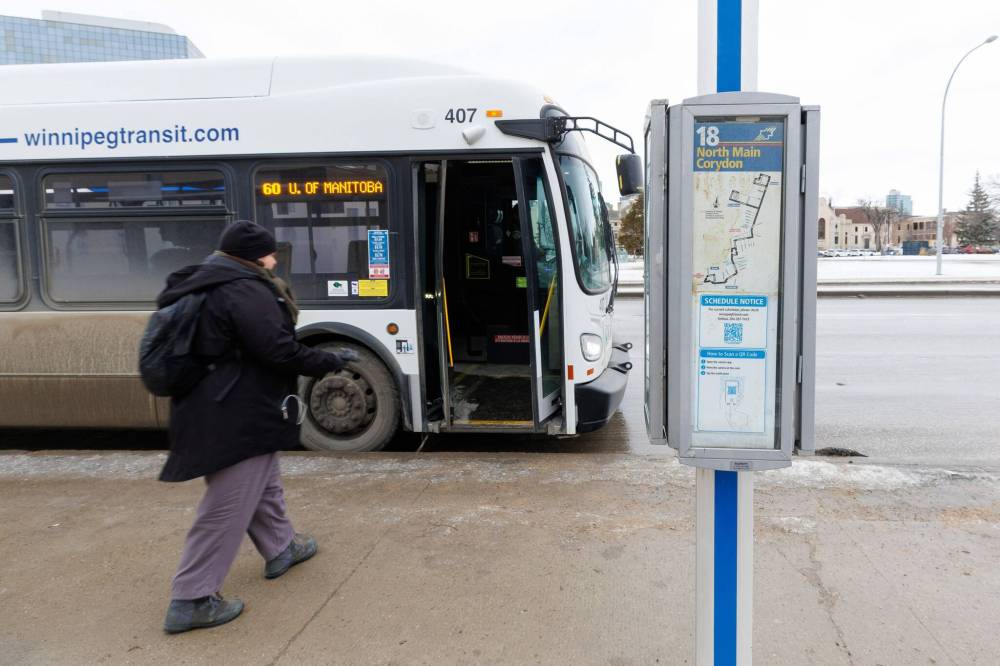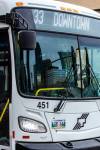City bus stops prone to ‘digital divide’
Read this article for free:
or
Already have an account? Log in here »
To continue reading, please subscribe:
Monthly Digital Subscription
$0 for the first 4 weeks*
- Enjoy unlimited reading on winnipegfreepress.com
- Read the E-Edition, our digital replica newspaper
- Access News Break, our award-winning app
- Play interactive puzzles
*No charge for 4 weeks then price increases to the regular rate of $19.00 plus GST every four weeks. Offer available to new and qualified returning subscribers only. Cancel any time.
Monthly Digital Subscription
$4.75/week*
- Enjoy unlimited reading on winnipegfreepress.com
- Read the E-Edition, our digital replica newspaper
- Access News Break, our award-winning app
- Play interactive puzzles
*Billed as $19 plus GST every four weeks. Cancel any time.
To continue reading, please subscribe:
Add Free Press access to your Brandon Sun subscription for only an additional
$1 for the first 4 weeks*
*Your next subscription payment will increase by $1.00 and you will be charged $16.99 plus GST for four weeks. After four weeks, your payment will increase to $23.99 plus GST every four weeks.
Read unlimited articles for free today:
or
Already have an account? Log in here »
Hey there, time traveller!
This article was published 03/01/2024 (689 days ago), so information in it may no longer be current.
Seyera Ibrahim is unable to check Winnipeg Transit’s schedule as she waits for the No. 16 bus at Osborne Street and York Avenue Tuesday.
Ibrahim’s phone is a basic model with no data options, so the QR code at the bus stop is useless to her. She’s memorized her schedule, but when the bus is late — or doesn’t show up — she has few options.
In Transit
A special series examining the state of Winnipeg’s public transportation system
Read the full series here.
“I’ve been doing this for many years, so I know… (but) I don’t have Wi-Fi to check,” Ibrahim said. “Sometimes there are (signs) in some places, but here, we don’t have that.”
Three years after Winnipeg Transit took down printed schedules at bus stops, and replaced them with QR codes — a lingering byproduct of the COVID-19 pandemic — questions are being raised about how effective they are for those who use Transit.
There are 154 stops in Winnipeg that have electronic signs that provide real-time next-bus information, but all of the other approximately 5,000 stops have no immediate access to updated scheduling.
Ibrahim would like every stop to have an electronic or printed schedule — no QR codes.
Fellow rider Derek Holke uses an app to determine when he should wait for his bus, and has never used the QR codes, but said he recognizes they’re less accessible than printed schedules.
“I don’t want to stereotype, but generally, people that are using public transit are going to be in the lower income bracket,” he said. “It’s a problem. Taking away the actual list, the physical list that used to be there with the times, it’s definitely a barrier.”
Before fall 2020, schedules changed four times a year, and routes with posted schedules would be updated as necessary. Winnipeg Transit said the replacement QR codes could mitigate unpredictable scheduling caused by the COVID-19 pandemic and represent a way to cut back on printouts.
Kyle Owens, president of the advocacy group Functional Transit Winnipeg, said the idea seemed convenient, if used in tandem with printed schedules at stops, but as regular bus service resumed, many riders haven’t found a use for the new system.
“We’ve seen so many electronic schedules that have broken and just never been repaired. We’ve seen so many features put in place and just not updated because the budget isn’t there from the city to ensure that infrastructure is being maintained,” he said.
“We have heard from people that they are frustrated with the QR codes, that they don’t know how to use them, or they don’t know how to understand what they’re looking at.”
MIKE DEAL / WINNIPEG FREE PRESS The Southbound Osborne at York bus stop Tuesday afternoon. The city has apparently removed schedules from some bus stops and is posting QR codes instead. Some argue that hurts those who don’t have phones or data.
While Winnipeg Transit’s union head Chris Scott called the change “innovative,” he acknowledged it creates hurdles for some.
“It’s crucial to acknowledge potential barriers for individuals without smartphones or tech proficiency, as reliance on digital schedules may pose challenges. Challenges also arise when the digital schedules at the corresponding stops malfunction or become inaccessible,” he said in an email. “While apps are an alternative, individuals lacking technological proficiency may face difficulties, contributing to a digital divide.”
A spokesperson for the City of Winnipeg noted riders are still able to call 311 for schedules, and the majority of stops did not have schedules prior to 2020.
Bringing back printed schedules — and expanding the program to include more stops — could be a low-cost, high-reward way to improve transit accessibility, Owens said.
malak.abas@freepress.mb.ca

Malak Abas is a city reporter at the Free Press. Born and raised in Winnipeg’s North End, she led the campus paper at the University of Manitoba before joining the Free Press in 2020. Read more about Malak.
Every piece of reporting Malak produces is reviewed by an editing team before it is posted online or published in print — part of the Free Press‘s tradition, since 1872, of producing reliable independent journalism. Read more about Free Press’s history and mandate, and learn how our newsroom operates.
Our newsroom depends on a growing audience of readers to power our journalism. If you are not a paid reader, please consider becoming a subscriber.
Our newsroom depends on its audience of readers to power our journalism. Thank you for your support.
History
Updated on Wednesday, January 3, 2024 1:01 PM CST: Adds fact box
Updated on Wednesday, January 3, 2024 1:05 PM CST: Changes format
















